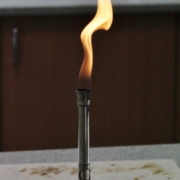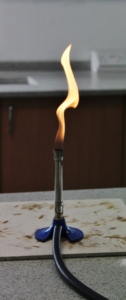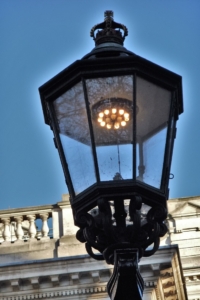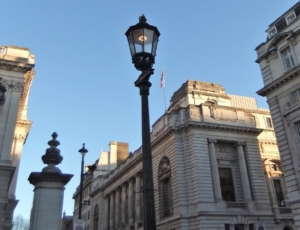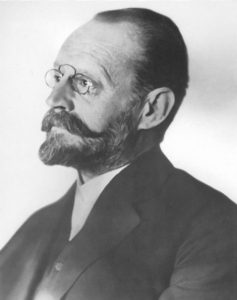Robert Bunsen – his burner and its impact on the gas industry
Article by Dr Fred Starr PhD, FIMMM, FIE, MIMechE, CEng
When thinking of key German Scientists, I recollect our Chemistry Lab, at my school in Stockton-on-Tees, where adorning the polished benches, was, in a sense, the greatest of all scientific devices, a set of Bunsen burners. Artifact of every Mad Scientist movie. The first real job for our aged, silvery haired, and distinguished Chemistry master, Mr Dee, was to show us how this amazing device worked. When the slider was closed, flame was luminous and wafted around in a lazy manner. True magic came with the opening of the slider, when the burner was noisier, and although now a transparent blue, was obviously hotter. “Never allow the flame to light back” he proclaimed. “The gas that’s produced will kill you!”
Within a few lessons, the Bunsen burner became a commonplace means of providing us kids with a flexible means of heating beakers and flasks. However, I don’t ever remember anyone telling us how it came about. If any of us did wonder, we would have surmised it was a lab version of the gas cooker that every home had at the time. But the burner came first, springing from the mind of Robert Bunsen, and the craftmanship of Peter Desaga, the instrument maker at the University of Heidelberg. Peter worked through a number of designs before he got something that was a success.
More often than not, the hard graft of the “technician”, in turning a concept into something useful, gets lost in the publicity for the inventor. In this country, the most scandalous example is how Watson Watt is acclaimed as the inventor of the British version of radar. In fact, the prototype, its design, and its setting up in a field in Northampton, to demonstrate the feasibility of radar, was done by Herbert Wilkins, a graduate technician, working for Watson Watt. Wilkins, by the way, also did the maths calculations, which showed that while a radio beam could not burn a pilot to a crisp, it would reflect back from aircraft approaching our shores. I wonder if my overseas readers could quote similar, and equally obnoxious examples from their own countries.
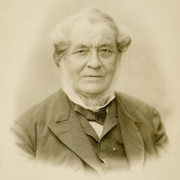
Robert Wilhelm Bunsen
Image: University Library Heidelberg, under Creative Commons Licence
Bunsen seems to be almost unique in the Annals of Science, in being quite without ego or self acquisitiveness. All that Bunsen claimed was the idea of mixing the gas with air in a tube before it reached the flame itself. Bunsen actually refused to patent his burner and stopped piratical manufacturers from claiming the device as their own. Ground breaking 19th Century chemistry, almost completely a German endeavour, needed such a tool to be freely available, to begin the job of creating chemistry as we know it. But the Bunsen burner, and Bunsen himself, as we shall see, gave us much more.
Heidelberg
There had been a chemistry department at Heidelberg, Germany’s oldest university when Bunsen arrived to take it over in 1852, with a remit to turn it into something bigger. He was able to establish a proper chemistry lab, a key feature of which was the availability of town gas, which he insisted in being piped in. Hence the invention of the burner.
Aged 33, when he arrived at Heidelberg, Bunsen was already a well known figure in the scientific world. In his travels, he had been to Iceland, showing why it was why geysers eject steam and water, periodically. Up to then an object of mystery. But it was as a chemist he was most well known, working on the extremely dangerous organic compound, cacodyl, which contained arsenic. I suppose his near poisoning by this horrible and inflammable material – “The smell of this body produces instantaneous tingling of the hands and feet, and even giddiness and insensibility” – and an explosion, in which a fragment of glass led to the loss of an eye, must have given him a certain amount of useful notoriety. Any publicity to an up and coming man being useful. Quite the opposite, if you are on the way down, of course!
In 1841, basing his ideas on a more expensive battery, that had used platinum for one of the electrodes, he had come up with the Bunsen Cell, substituting carbon for platinum. It provided a cheap and reliable source of current, in the days before electric mains power. It allowed Bunsen, using electrolysis, to isolate the elements chromium, magnesium, aluminium, manganese, sodium, barium, calcium and lithium. Others were to follow. Here, it is worth remarking that Demetri Mendeleev, the author of the periodic table, spent two years in 1859 and 60 working in Bunsen’s laboratory. Being able to see in solid form, newly discovered metals that would have to be incorporated into his table of the elements, must have been a stimulus to Mendeleev’s subsequent work.
Clearly, Bunsen and his well equipped lab was attracting some of the best scientists. By all accounts he was a decent person to work with, giving his students and co-workers a good steer, without appropriating the results to himself. He worked across faculties and was instrumental in getting Gustav Kirchhoff and his spectrometer into the Physics Department at Heidelberg, where the two of them began to use this instrument to identify new elements. For this, the Bunsen burner was ideal. Salts of any elements would colour the flame, in a characteristic manner. Yellow, for sodium, green for copper, for example. Examining the flame with the spectroscope gave an even more positive identification.
Saviours of the gas industry
Let’s change our story, stepping west about 850 km, and 150 years in time, and take an evening stroll, first in London’s St James’ Park, and then down Charlotte Street in the heart of the West End. In the Park you will see arrays of gas lamps of the conventional type. Look carefully and you will see that the illumination comes from an incandescent gas mantle, a few centimetres in size. There is no flame. These are reproductions a late 19th century lamps, and although nothing in comparison with modern street lighting, are actually pretty good.
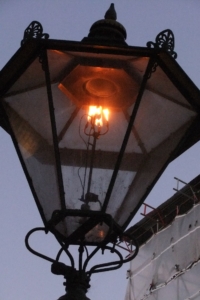
Close-up of burner arrangement
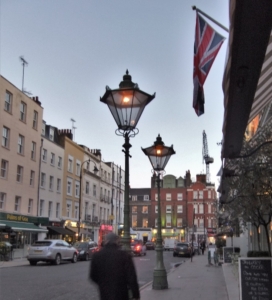
Old-style flame-type lamps in Charlotte Street
What about Charlotte Street? There are only two gas lamps and they are of the type that was used for lighting in the major towns of cities of Europe, for about sixty years after the gas industry came into existence. When first introduced, the sole use of “town gas”, being produced by heating coal, was for lighting streets and house interiors. The only competitors were crudely made candles, and slightly more sophisticated lanterns. The latter were, almost literally, burning their way through the whale population of the North Atlantic in the hunt for oil.
The Charlotte Street lamps burn gas, in a very crude manner, producing a candle-like flame. As the yellowish-looking and discoloured glass panes of these lamps indicate, the flame is slightly smoky. Lighting like this only persisted so long because there was no real opposition. But gas lighting seemed doomed with the appearance of electricity. Without some technical development, the gas Industry would have quickly followed.
One can trace its salvation to Bunsen and Desaga and their clean-burning burner. As mentioned, Bunsen’s laboratory had become the world centre for methods needed to identify and isolate new elements. Here I am indebted Professor Andrea Sella of University College, London, who noted that Bunsen had said to one of his students, Auer Von Welsbach, “that the problem of domestic illumination would one day be solved by having a solid oxide glow in a flame”.
Subsequently in trying to isolate the element Praseodymium from Neodymium, he dipped a piece of cotton wool into a solution of the salts of these two elements, before putting the cotton wool into a Bunsen flame. The surprise was that, after the cotton burnt away, it left a skeleton of oxides of the two elements, produced a very bright light, just as Bunsen had envisaged. Von Welsbach was onto something. To cut a long story short, he worked through the newly discovered sets of elements, eventually settling on a mixture of the salts of thorium and cerium, which give a whitish colour. Hence the lamps in St James’ Park.
The fact that the emission of energy is as visible light, without too much heat, suggests that we have a quantum mechanical action at work. If so, this would predate, by a long stretch, fluorescent light and the LED, which also rely on energy jumps of electrons to provide us with illumination.
For a good few decades, gas, being cheaper than electricity, continued to light our streets and homes. As the generation of electricity became more efficient, gas lighting came under an irresistible threat. We did try to fight back! Back in my old research establishment in London, on the site of one of the world’s oldest gasworks, I came across a 1920’s hand written report comparing gas and electricity in the homes. After comparing the lighting power of gas mantles and electric lights, the report triumphantly proclaimed that gas was cheaper. In addition, it added, that the heat from the gas mantle reduced heating bills!
More salvation
Simply relying on lighting would not have been the answer to an increasingly competitive supply of electricity. For the domestic user, even those relying on electric light, cooking by gas, and to a much lesser extent, heating using a radiant fire was a market on which the Gas Industry could rely. Both relied upon the Bunsen-Desaga principle, in which the gas and air are premixed before they reach the burner nozzles. The aim here is, not so much to produce a high temperature flame, but one that doesn’t produce soot and hydrocarbon smells.
Here it worth mentioning the gas-fired “geyser boiler” to supply hot water, installed in every bathroom up to about 1950. The name, which must have begun as a joke, looked back to Bunsen’s discovery in Iceland, where he explained how a natural geyser was able to shoot forth steam and boiling hot water. Sometimes every few minutes, sometimes every few hours. Geyser bathroom boilers seems to act in the same way, but in a less predictable manner. Much of the time, one would get a stream of lukewarm water, just about bearable on an average British day. Other times with the most violent banging, a mixture of steam and scalding water would issue forth.
The future of gas
We now burn natural gas, not town gas, and being a geological resource supplies are limited. A few decades ago, Britain was exporting gas from the North Sea. Now we import more than half. In Germany it an incredibly high 94%, the majority coming from Russia. So, converting the domestic gas network over to renewable hydrogen looks interesting.
If it were to come, it would, in my lifetime, be the second time where we, in Britain, would need a complete and costly substitution of the burners in central heating systems, gas cookers and gas fires. In the 1960s this was required because of the changeover from town to natural gas. The hydrogen economy could necessitate a similar transformation. People who worked in the Gas Industry at the time will remember the publicity we got for the occasional foul up.
It has been forgotten that the Welsbach mantle and Bunsen Burner combination was so different from the earlier crude type, that these had to be changed, too. In Britain Government legislation was also involved. When gas was first introduced, it had to contain a plentiful supply of hydrocarbons, so as to produce a nice yellow candle-like flame, which was enforced by the law. Gas like this sooted up the mantles, the solution being the production of town gas that was “less rich”. New legislation was needed.
Renewable hydrogen will be rather more expensive than natural gas, and it is possible that at some point in the future the domestic gas system will fall into disuse. What then, I wonder, for the chemistry classes in schools and universities? How can they possibly get by without their old and trusted friend, the Bunsen burner?
Fred Starr : 9th July 2021
Further writings and publications by Fred Starr are available online at FredStarr.com
Editor’s Note: Bunsen’s scientific work was in German, prompting skilled technical translation into English, given the commercial demand for gas technology.

